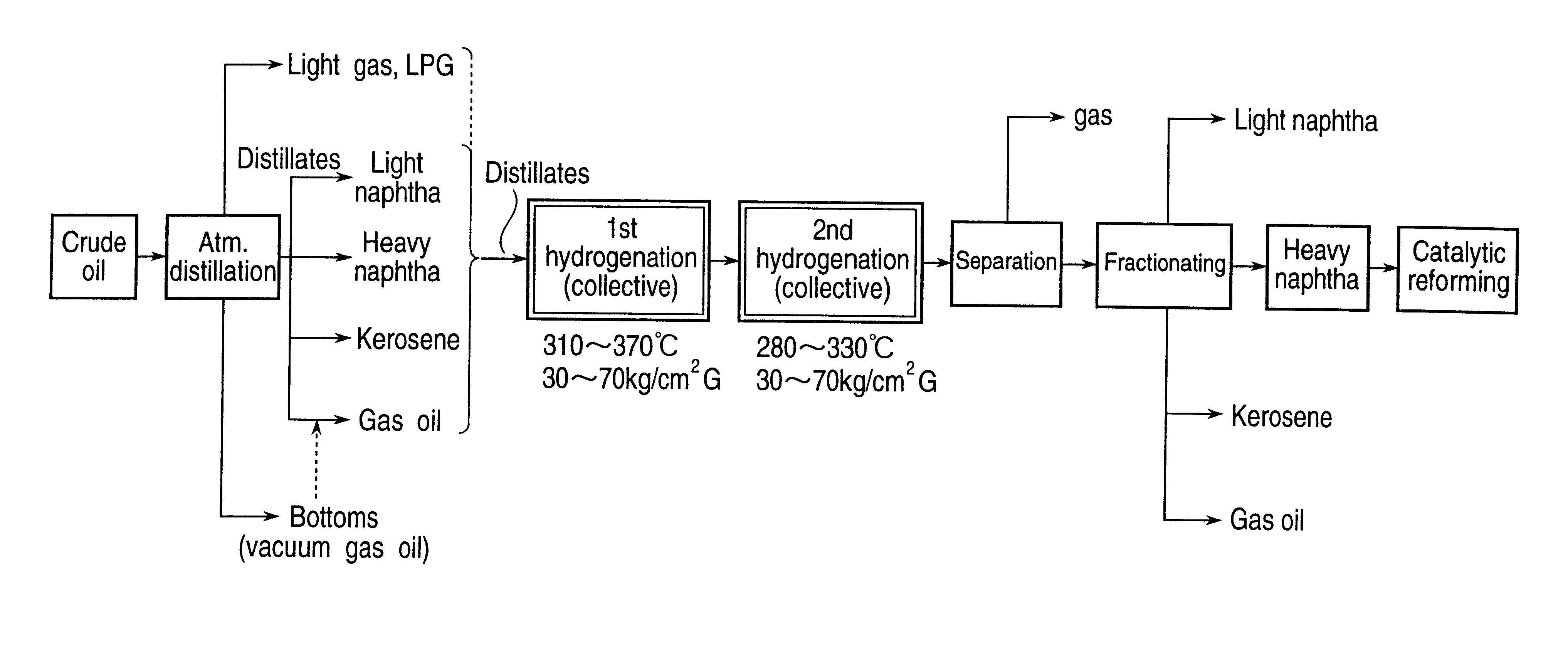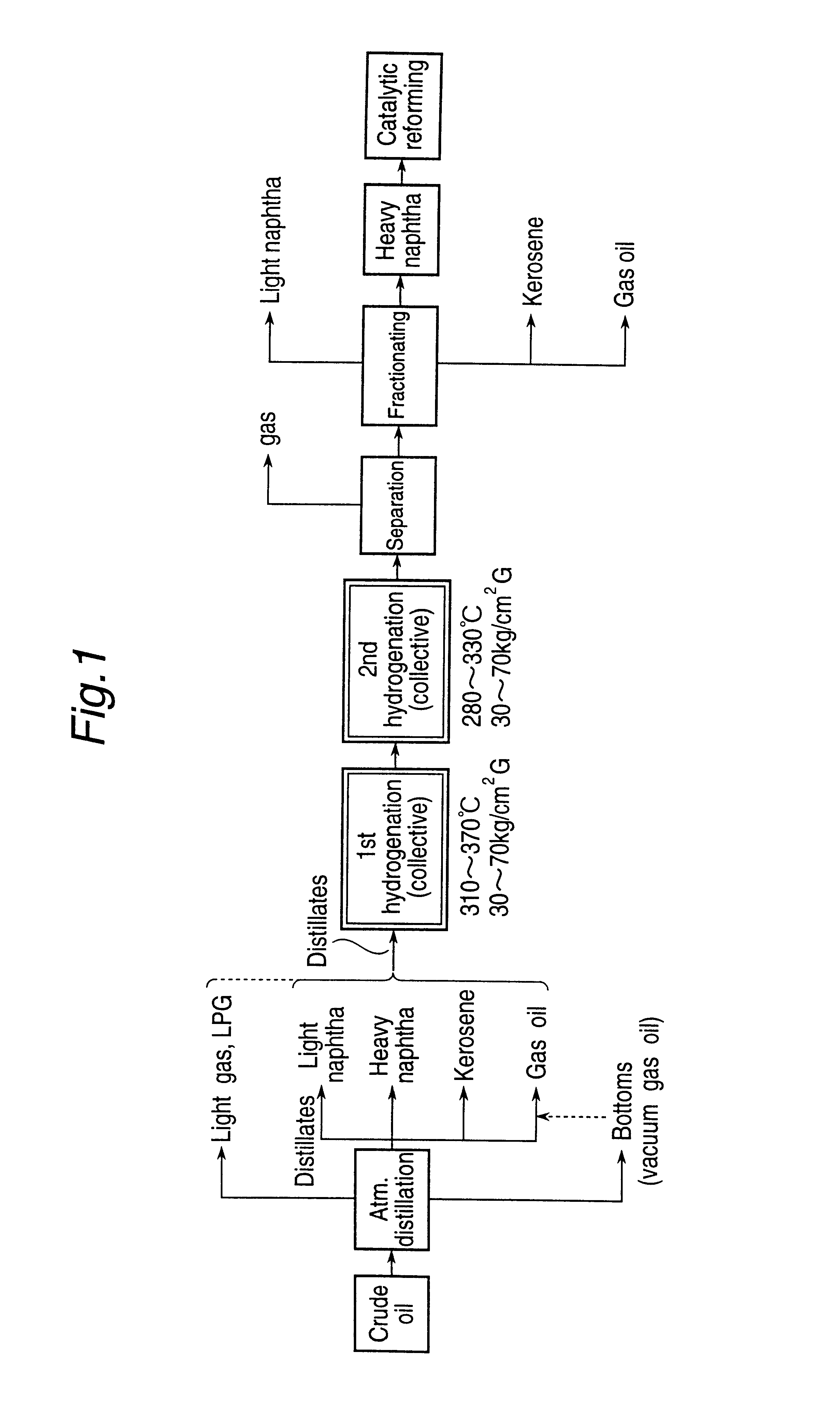Petroleum processing method
a technology of hydrogenated naphtha and processing method, which is applied in the direction of hydrocarbon oil cracking, hydrocarbon distillation, catalytic naphtha reforming, etc., can solve the problems of high construction cost, large facilities required, and high sulfur content of hydrogenated naphtha, and achieve efficient separation and purification of crude oil
- Summary
- Abstract
- Description
- Claims
- Application Information
AI Technical Summary
Benefits of technology
Problems solved by technology
Method used
Image
Examples
examples 1 to 6
Crude oil (crude oil consisting of a 50:50 (volume ratio) mixture of Arabian light crude oil and Arabian heavy crude oil, having a sulfur content of 2.40% by weight) was processed by the process shown in FIG. 1. Fraction ratios and sulfur contents (% by weight) of the distillates obtained by the atmospheric distillation of the crude oil are listed in Table 1.
Of these fractions, light naphtha, heavy naphtha, kerosene and gas oil fractions were collectively subjected to the first hydrogenation step and the second hydrogenation step.
Hydrogenation conditions employed in the first hydrogenation step and the sulfur contents of the thus obtained fractions are as described below and as given in Table 2. The sulfur content of the whole processed oil was 0.02% by weight.
First Hydrogenation Step
Reactor: gas-liquid downstream parallel flow coil reactor (inside diameter of 8 mm.times.length of 3500 mm),
Catalyst: commercially available Co--Mo catalyst (produced by Catalysts & Chemicals Industries...
examples 7 to 9
Oil refining was performed by the process of FIG. 2.
Specifically, the same distillates to be collectively processed as in Example 1 were collectively processed in the same manner as in the first hydrogenation step of Example 1 and subjected to atmospheric distillation. The thus obtained heavy naphtha was subjected to the second hydrogenation under the conditions specified in Table 4 and, thereafter, to adsorption. The adsorption was conducted with the use of zinc oxide (ZnO) adsorbent. Processing conditions and results are given in Table 4.
Second Hydrogenation Step
Reactor: gas-liquid downstream parallel flow coil reactor (inside diameter of 8 mm.times.length of 2000 mm),
Catalyst: commercially available Co-Mo catalyst (produced by Catalysts & Chemicals Industries Co., Ltd.), and
Amount of catalyst: 100 ml.
Adsorption Step
Adsorber: cylindrical adsorber (inside diameter of 30 mm.times.length of 400 mm),
Adsorbent: commercially available ZnO adsorbent (produced by Nikki chemical Co., Ltd.)...
PUM
| Property | Measurement | Unit |
|---|---|---|
| temperature | aaaaa | aaaaa |
| boiling point | aaaaa | aaaaa |
| temperature | aaaaa | aaaaa |
Abstract
Description
Claims
Application Information
 Login to View More
Login to View More - R&D
- Intellectual Property
- Life Sciences
- Materials
- Tech Scout
- Unparalleled Data Quality
- Higher Quality Content
- 60% Fewer Hallucinations
Browse by: Latest US Patents, China's latest patents, Technical Efficacy Thesaurus, Application Domain, Technology Topic, Popular Technical Reports.
© 2025 PatSnap. All rights reserved.Legal|Privacy policy|Modern Slavery Act Transparency Statement|Sitemap|About US| Contact US: help@patsnap.com



